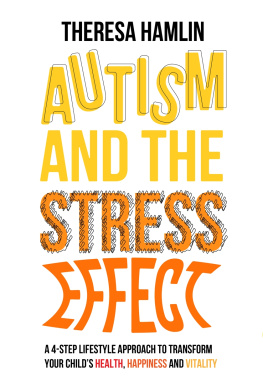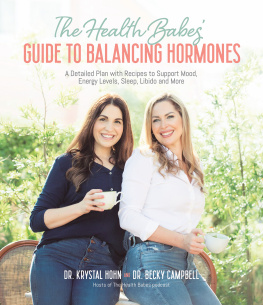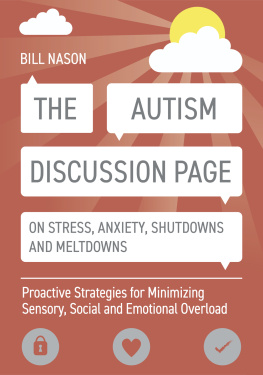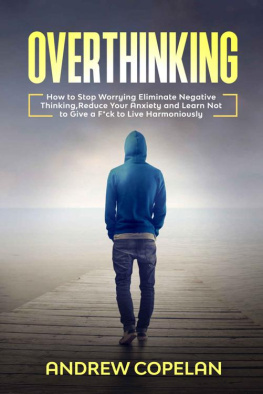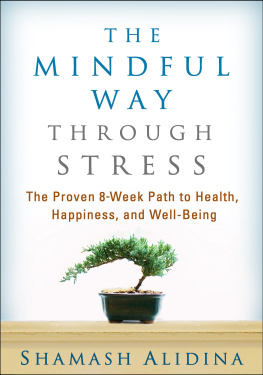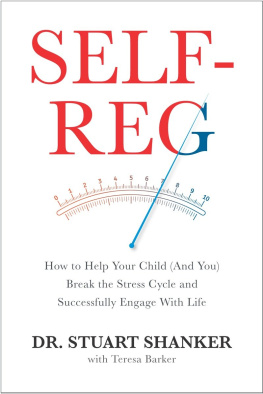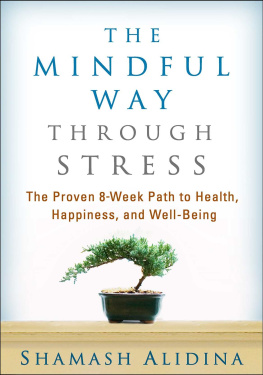
AUTISM
AND THE STRESS EFFECT
of related interest
Supernourishment for Children with Autism Spectrum Disorder
A Practical Nutritional Approach to Optimizing
Diet for Whole Brain and Body Health
Angelette Mller
ISBN 978 1 84905 383 9
eISBN 978 0 857007 46 9
Reframe Your Thinking Around Autism
How the Polyvagal Theory and Brain Plasticity
Help Us Make Sense of Autism
Holly Bridges
Foreword by Stephen W. Porges
ISBN 978 1 84905 672 4
eISBN 978 1 78450 177 8
Autism Movement Therapy (R) Method
Waking up the Brain!
Joanne Lara with Keri Bowers
Foreword by Stephen M. Shore
ISBN 978 1 84905 728 8
eISBN 978 1 78450 173 0
AUTISM
AND THE
STRESS
EFFECT
A 4-STEP LIFESTYLE APPROACH
TO TRANSFORM YOUR CHILDS
HEALTH, HAPPINESS, AND VITALITY
THERESA HAMLIN
FOREWORD BY DR. TEMPLE GRANDIN
AND DR. JOHN RATEY

Jessica Kingsley Publishers
London and Philadelphia
Bristol Stool Chart on p.226 is reproduced with kind permission from Dr KW Heaton, formerly Reader in Medicine at the University of Bristol. 2000 produced by Norgine group of companies.
First published in 2016
by Jessica Kingsley Publishers
73 Collier Street
London N1 9BE, UK
and
400 Market Street, Suite 400
Philadelphia, PA 19106, USA
www.jkp.com
Copyright Theresa Hamlin 2016
Foreword copyright Temple Grandin and John Ratey 2016
All rights reserved. No part of this publication may be reproduced in any material form (including photocopying or storing it in any medium by electronic means and whether or not transiently or incidentally to some other use of this publication) without the written permission of the copyright owner except in accordance with the provisions of the Copyright, Designs and Patents Act 1988 or under the terms of a licence issued by the Copyright Licensing Agency Ltd, Saffron House, 610 Kirby Street, London EC1N 8TS. Applications for the copyright owners written permission to reproduce any part of this publication should be addressed to the publisher.
Warning: The doing of an unauthorised act in relation to a copyright work may result in both a civil claim for damages and criminal prosecution.
Library of Congress Cataloging in Publication Data
Hamlin, Theresa.
Autism and the stress effect : a 4-step lifestyle approach to transform your child's health, happiness
and vitality / Theresa Hamlin ; foreword by Temple Grandin and John Ratey.
pages cm
Includes bibliographical references and index.
ISBN 978-1-84905-748-6 (alk. paper)
1. Autism--Psychological aspects. 2. Stress (Psychology) 3. Diet. 4. Exercise. I. Title.
RC553.A88H3518 2015
616.85'8820651--dc23
2015018549
British Library Cataloguing in Publication Data
A CIP catalogue record for this book is available from the British Library
ISBN 978 1 84905 748 6
eISBN 978 1 78450 178 5
This book is dedicated to the staff at The Center for
Discovery who give of themselves tirelessly to support
and enhance the lives of our children and their families.
CONTENTS
FOREWORD
Dr. Temple Grandin & Dr. John Ratey
Autism is a broad spectrum and there is a huge shortage of information to help individuals with the most severe complex forms of autism. Many of these individuals remain nonverbal, lack basic daily living skills and may have destructive behavior. Many behavior problems are caused by being in a constant state of stress due to the noise of sensory over sensitivity.
This insightful book describes a multi-pronged approach of correcting health problems that contribute to disruptive behavior, lots of exercise, and behavioral methods. Careful use of medication is also part of the program.
Parents and teachers who work with older children and adults with severe autism, who are either nonverbal or only partially verbal, should read this book.
Dr. Temple Grandin, Author
The Autistic Brain
Thinking in Picture s
Stress can be harmful for all of us, but especially for those with other underlying problems like autism spectrum disorder (ASD). Stress becomes particularly toxic when it doesnt end; this creates an inner world of what I call noise. In this state, the best of us cannot pick out the relevant data from the background, and are often in a non-stop panic state that is a booming, buzzing confusion. From my perspective as a psychiatrist, it is one of the most important concepts to understand and navigate in the treatment of autism.
It was at the start of my career, almost 35 years ago, that I had my first exposure to patients with ASD and their reaction to stress. They were severe, adult cases, exhibiting aggression and self-abusive behavior. Patients were often heavily drugged, misdiagnosed as having everything from schizophrenia to manic depression, and housed in chronic mental hospitals. Witnessing and breaking down the destructive behaviors exhibited in such an un-healing environment led me to writing a paper called The Concept of Noise. It recognized that aggression and self-abusive behavior in the autistic brain is frequently a nonverbal expression of internal stress. The paper not only theorized a new way of looking at ASD behaviors, it also led to my lifelong relationship with Temple Grandin. Temple is famous for giving voice and articulating what its like to be inside the mind of someone with ASD. While attending one of her lectures in Boston, Temple quoted the Concept of Noise paper, confirming a noisy brain is a good description for the autistic brain, especially under any kind of stress. Temple has been instrumental in my continual learning and understanding of what might be going on in the brain and feeling state of autistic individuals, with stress leading to more confusion, more uncertainty, and more noise.
We now know if the noisy state is unrelenting, for a number of reasons, it is difficult, if not impossible, for change, healing, and progress. From a biological perspective, when toxic stress is reduced, there is an increase in the brains neuroplasticity, the necessary tool to learn and retain new information and behaviors. If we dont take the important steps of reducing the high stress levels most ASD people find themselves experiencing, learning compensatory and situationally appropriate behaviors and strategies becomes overwhelming, with frustrations erupting in meltdowns and what we used to call catastrophic reactions. This increase in internal disorientation not only generates aggressive, self-abusive, self-stimulatory behaviors, but also flight or internal withdrawal. These uncontrollable behaviors are both heartbreaking and frustrating for families, caregivers, and those living with autism, no matter where they may be on the spectrum.
If there is anywhere in the world examining and employing best practices for reducing internal stressors and noise, it is The Center for Discovery (TCFD) in upstate New York. Headed by Patrick Dollard, an internationally recognized thought leader in the field, TCFD cares for hundreds of developmentally disabled students, including 250 individuals living on the extreme end of the autism spectrum. Many of them are nonverbal or struggle to communicate as well as having difficulty with self-care. For over 30 years, Dr. Terry Hamlin has taken the leading role in overseeing the groundbreaking programs, research and therapeutic tactics employed by TCFD. While treatment norms for ASD in the past have usually consisted of the basics of medication and behavioral therapy, TCFD has developed a revolutionary, all encompassing holistic approach geared specifically to the ASD individual. With her experienced and caring staff, Dr. Hamlin has been at the forefront of finding the best ways to lower negative stressors, while at the same time, building on coping mechanisms, introducing new, healthier behaviors, and employing methods to make it all stick. Impressive results have been achieved by going beyond the pharmaceutical and behavioral fixes, incorporating and recognizing concepts often overlooked or under-utilized in the treatment of ASD; the importance of proper diet, the contribution of adequate sleep, the benefits of exercise and movement, the positive results of being in nature, all while aiding those with ASD in improving their interaction and connection
Next page
